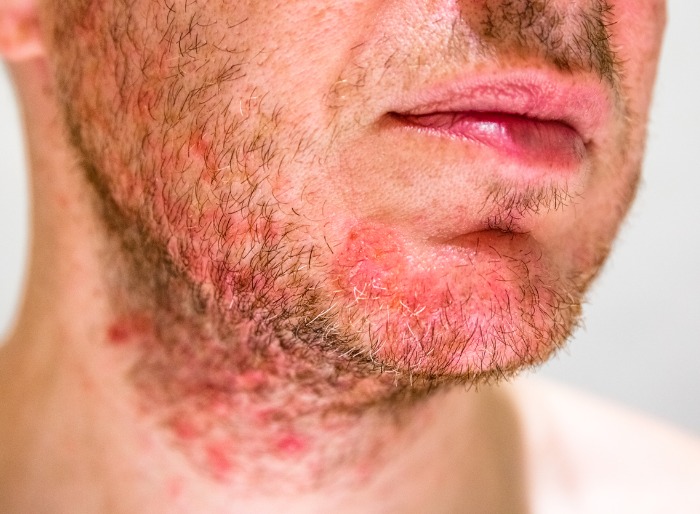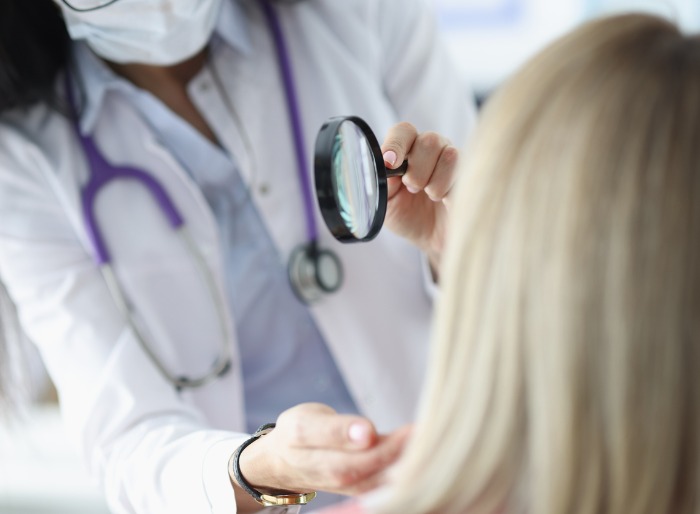If you have a red-colored rash around your mouth, you might have perioral dermatitis, which causes the skin to become scaly and flaky, with inflamed patches that might itch and burn. In some cases, the rash can spread from the area around the mouth to the nose and eyes. Topical steroids are typically considered to cause perioral dermatitis, but there are other causes. Our Gainesville dermatologists with Dermatology Associates provide the highest quality of care possible using state-of-the-art technology and innovative techniques for skin conditions, including perioral dermatitis. Contact our full-service dermatology practice. Contact Dermatology Associates today to schedule an appointment for treatment.

What Is Perioral Dermatitis?
In the word perioral, “peri” means “around,” and “oral” refers to the mouth. Perioral dermatitis is a type of dermatitis characterized by the appearance of a red rash circling the mouth. The rash often appears as small, red, acne-like breakouts in people with light skin tones and skin-colored, hyperpigmented, or brown breakouts in people with darker skin tones. Due to its characteristic appearance, this skin disorder may be mistaken for acne or rosacea. Perioral dermatitis can develop and last for weeks, months, or even years, though there are clinical treatments to help patients effectively manage their condition.
This chronic dermatitis can occur in individuals of all ages, races, and ethnicities. The pustules, or bumps, may contain a clear fluid discharge. Slight itching and sensations of burning may also occur. This condition may resolve after the triggers, or offending agents are removed. There are two types of perioral dermatitis: typical perioral dermatitis and granulomatous perioral dermatitis. Granulomatous perioral dermatitis is an irregular version of perioral dermatitis, which features yellow-colored papules.
Perioral Dermatitis Symptoms
The clinical features and characteristics of perioral dermatitis include the following symptoms. For additional information about this condition, please contact our dermatology specialists.
- Unilateral or bilateral eruption of papules on the chin, upper lip, and eyelids
- Sparing of the skin that borders the lips, eyelids, and nostrils
- Clusters of tiny, inflamed, red-colored papules or papulopustules
- Dry, inflamed, and flaky skin surface
- Itching and burning irritations in the affected areas
Perioral Dermatitis Causes Or Triggers
The exact perioral dermatitis cause is to be determined. However, the following are potential causes.
- Topical steroid creams
- Inhaled prescription steroid sprays
- Heavy face creams and moisturizers
- Fluorinated toothpaste
- Chewing gum
- Dental fillings
- Hormonal changes
- Oral contraceptives
- Improper function of the epidermal barrier
- Activation of the innate immune system
- Follicular fusiform bacteria
- Candida albicans
- Altered cutaneous microflora
Is Perioral Dermatitis Contagious?
No. Perioral dermatitis is not contagious and cannot be spread by person-to-person. The long-term use of the following can cause it.
- Topical steroid medications
- Certain inhaled asthma medications
- Heavy moisturizer products
- Heavy, oily sunscreens
How Is Perioral Dermatitis Diagnosed?
Dermatologists can typically diagnose perioral dermatitis based on a skin exam, with no tests required. Sometimes, dermatologists perform a skin culture test for bacteria to determine any evidence of infection. In some cases, your doctor may perform a skin biopsy, particularly when there is something unusual about the skin’s presentation. During the biopsy, your doctor takes a small portion of the affected skin and sends the sample for testing. Your dermatologist may also perform a skin biopsy if the rash has not responded to standard treatments for perioral dermatitis.
Can Perioral Dermatitis Become Rosacea?
Individuals with perioral dermatitis who undergo treatment for this condition may find that their condition returns after treatment. This may occur when perioral dermatitis is successfully treated. A significant portion of cases in which perioral dermatitis returns can develop into rosacea, which causes the development of red papules in the middle of the face, including the nose and cheeks, among other facial regions.
Is Perioral Dermatitis Permanent?
Perioral dermatitis may become a permanent condition instead of a chronic condition if you do not seek and obtain effective treatment. In most cases, the condition resolves, but this may take weeks or even years. If you do find treatment, your symptoms and rash are likely to dissipate much sooner than they might without treatment. While treatments can help patients effectively manage their perioral dermatitis, there is no cure.
Perioral Dermatitis Treatment
The primary step of the perioral dermatitis treatment process is to stop using products that can cause, trigger, or contribute to perioral dermatitis flare-ups. This can include topical and inhaled steroids, face creams, cosmetic products, sunscreen, fluorinated toothpaste, and chewing gum, among other items. Patients’ perioral dermatitis might flare up after they stop using a topical steroid, so their doctor may recommend using a lower concentration of steroid instead of stopping the use altogether. Discuss this with your healthcare provider. In many cases, perioral dermatitis can become worse before it gets better. Several medications can help patients manage their perioral dermatitis symptoms. Unfortunately, however, these medications may take some time to take effect. Following treatment, it can take days, weeks, or months for perioral dermatitis symptoms to disappear.
Your healthcare provider may recommend one or more of the following topical treatments for perioral dermatitis.
- Erythromycin gel
- Clindamycin lotion or gel
- Metronidazole cream or gel
- Pimecrolimus
- Azelaic acid
- Sulfur preparations
- Tacrolimus ointment
In some cases, oral antibiotics may be prescribed for treating perioral dermatitis. These medications can help reduce inflammation. In many cases, oral antibiotics are used in combination with topical treatments. Your healthcare provider may recommend a medication from the tetracycline family.
Is There A Cure For Perioral Dermatitis?
There is not yet a cure for perioral dermatitis. Perioral dermatitis may remain for months or years. While there is no cure for this skin condition, long-term remissions are possible. In some people, the rash disappears and then reappears. The same treatments used during the initial outbreak will likely be effective for treating subsequent flare-ups. The rash can become more severe after patients stop using a topical steroid. The flare-up will fade with time.

Can I Prevent Perioral Dermatitis?
Because the risk factors for perioral dermatitis vary widely from person to person, and the cause of the condition is not completely known, there is no foolproof method for preventing it. There are some steps patients can take, however, to help alleviate their symptoms or prevent them from becoming more severe. Speak with your dermatologist about the best ways to take care of your skin and to learn more about how to treat perioral dermatitis while at home. For additional information about this condition and possible options available to you for treating it, please contact our dermatology office.